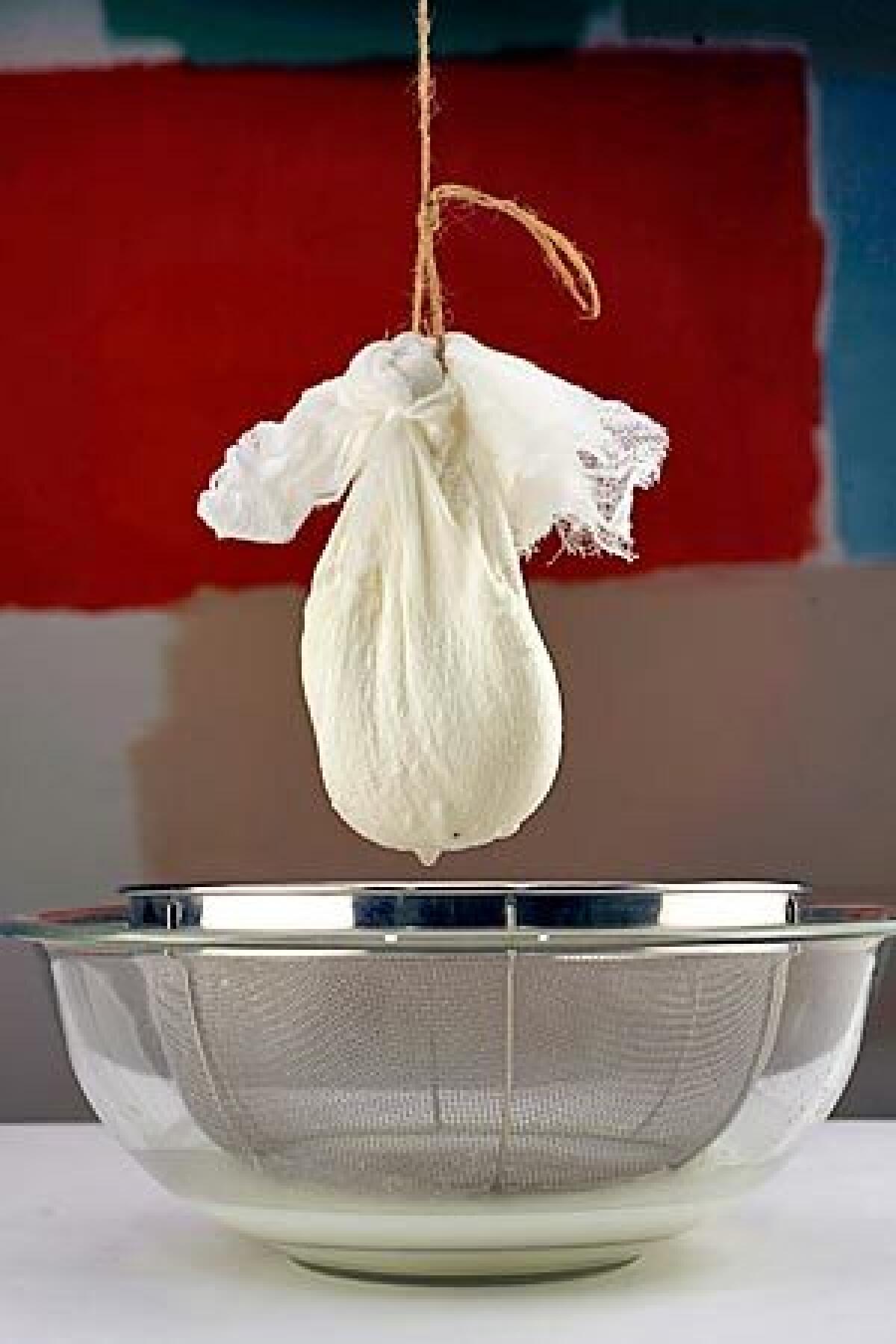Fresh homemade cheeses for Shavuot

Sometimes when I’m in the kitchen making fresh cheese, I imagine what it must have been like for the primitive nomads who first discovered that the fresh, sweet liquid they had so laboriously milked from their precious flocks quickly soured in the goatskin storage bag. The choice was simple -- either throw it away or learn how to preserve and enjoy it. The solution was ingenious, though not surprising: the invention of sour-milk-based dairy products and cheeses.
FOR THE RECORD:
Jewish festival: A Food section article about the Jewish holiday Shavuot said the festival ended at sundown Friday. That is the practice in Israel. For most Jews in the United States, it ended at sundown Saturday. —
I’ll be making fresh cheeses again for Shavuot, the Jewish harvest festival celebrated this year beginning at sundown Thursday and running through sundown Friday. In ancient times, Shavuot was a joyous pilgrimage festival celebrating the annual wheat harvest, when thousands of farmers and their extended families traveled to the Great Temple in Jerusalem to offer a basket of wheat and their first fruits to God. Then, acting on behalf of the whole nation, the high priest would place on the altar the offering that is unique to Shavuot: two loaves of bread, baked from the newly harvested wheat. So why make cheese?
Because just as the holiday has changed over the millenniums, so have the culinary customs. Centuries after the destruction of the Temple, exiled to foreign shores, the scholars of the Talmud infused the holiday with new meaning; the ancient harvest festival, they explained, coincided with a “spiritual harvest” -- namely, the date the Torah was revealed to Moses on Mt. Sinai.
To prepare for this blessed event, legend has it that the children of Israel ate only dairy products to purify themselves, and in Hebrew numerology, or gematria, the word for milk (halav) equals 40 -- the same number of days Moses spent on Mt. Sinai as he waited to receive the laws. This was incentive enough to have dairy products evolve as an integral part in the holiday’s fare.
Nature itself, though, provides another explanation. Like the spring holidays of ancient Canaan and Rome, Shavuot occurs in the season when animals grazing in the lush pastures green from winter rains produce an abundance of milk; cheese-making, too, was part of spring harvest festivals around the world.
But in those days, you wouldn’t expect to find a Roquefort or a cheddar. Even before the advent of global warming, the hot climate in the Middle East precluded the aging of cheese. Instead, what you would expect to find is creamy fresh white cheeses that were eaten fresh, rolled into balls and packed in olive oil, or dried in lumps for transporting on camelback to be grated as need be.
For example, yogurt cheese (labneh) was an excellent way to expand the limited repertoire of foods in the diet and prolong the “shelf life” of yogurt. It could be drained until soft and used as a spread, or left to drain until firm and turned into balls, which could then be marinated in olive oil and herbs for extended storage.
To make it, place a large wire-mesh strainer inside a large bowl. Cut three or four layers of cheesecloth into 20-inch squares. Moisten the cheesecloth in cold water, then wring out and line the strainer. Spoon a quart of cow’s, sheep’s or goat’s milk yogurt into the cheesecloth, then gather up the edges of the cheesecloth, pressing the yogurt just a little to extract some of the liquid. Twist the four corners to squeeze out more of the liquid. Untwist the cloth and tie two sides of the fabric together. Suspend the package over the bowl or a sink, leaving it to drain at room temperature until the yogurt is the consistency of cream cheese, several hours to overnight. (Squeeze the package from time to time to speed draining.)
Or do the same thing with a quart of sour cream (seasoned with about one-half teaspoon salt), leaving it to drain until it is soft -- three or four hours -- and you can use it as a first course for dipping with bread, in the same way that hummus or labneh is used today. Allowed to drain slightly longer -- say, overnight -- it can become sufficiently firm to be made into balls, like labneh. It is a superb substitute for regular cream cheese in any recipe.
So to add a little authenticity to my holiday table, I already have my yogurt and sour cream draining in separate cheesecloth bundles over my kitchen sink. We’re certainly no longer nomads, and our shiny refrigerators will keep milk fresh just about as long as we want it. But making your own fresh cheese takes virtually no work and tastes better than anything you could buy in a store.
More to Read
Eat your way across L.A.
Get our weekly Tasting Notes newsletter for reviews, news and more.
You may occasionally receive promotional content from the Los Angeles Times.






